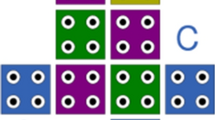Abstract
As an emerging technology device, Quantum-dot cellular automata (QCA) may be a suitable substitute for traditional semiconductor transistor technology. Arithmetic logic unit in field-coupled QCA has been also studied extensively in recent year. In this paper, the new low-power Exclusive-OR gate is presented, which is mainly based on QCA cellular leveled format. This Exclusive-OR gate can be used to design various useful QCA circuits. By using this gate, we design and implement a novel full adder circuit with low dissipation. The circuit is designed using only 45 normal cells in a single layer without crossover. Compared with previous designs, both decimal adders achieve better performance in terms of latency and overall cost. The operation of the proposed circuit has been verified by QCADesigner version 2.0.3 and energy dissipation investigated by QCAPro tool. We also compared with previous designs in terms of power dissipation, cell-counts, area, latency and cost. The proposed full adder has the smallest area with less number of cells. And the total energy dissipation of our proposed full adder are only 0.05112 eV, 0.07454 eV and 0.10181 eV when tunneling energy levels are 0.5 Ek, 1 Ek and 1.5 Ek, respectively. The proposed single full adder also has the lowest total energy dissipation with a reduction of 20.94, 11.25 and 4.82% in 0.5 Ek, 1 Ek and 1.5 Ek tunneling energy levels, respectively when compared with the previous most power-efficient design.



















Similar content being viewed by others
References
Cavin, R.K., Lugli, P., Zhirnov, V.V.: Science and engineering beyond Moore's law. Proc. IEEE. 100, 1720–1749 (2012)
Lent, C.S., Tougaw, P.D., Porod, W., Bernstein, G.H.: Quantum cellular automata. Nanotechnology. 4(1), 49–57 (1993)
Lent, C.S., Tougaw, P.D.: Lines of interacting quantum-dot cells: a binary wire. J. Appl. Phys. 74(10), 6227–6233 (1993)
Lent, C.S., Tougaw, P.D.: A device architecture for computing with quantum dots. Proc. IEEE. 85(4), 541–557 (1997). https://doi.org/10.1109/5.573740
Tougaw, P.D., Lent, C.S.: Logical devices implemented using quantum cellular automata. J. Appl. Phys. 75(3), 1818–1825 (1994)
Gin, A., Tougaw, P.D., Williams, S.: An alternative geometry for quantum-dot cellular automata. J. Appl. Phys. 85(12), 8281–8286 (1999)
Srivastava, S., Sarkar, S., Bhanja, S.: Estimation of upper bound of power dissipation in QCA circuits. IEEE Trans. Nanotechnol. 8(1), 116–127 (2009). https://doi.org/10.1109/Tnano.2008.2005408
Srivastava, S., Asthana, A., Bhanja, S., Sarkar, S.: QCAPro - an error-power estimation tool for QCA circuit design. 2011 IEEE International Symposium of Circuits and Systems (ISCAS). Rio de Janeiro, 2377–2380 (2011). https://doi.org/10.1109/ISCAS.2011.5938081
Kianpour, M., Sabbaghi-Nadooshan, R., Navi, K.: A novel design of 8-bit adder/subtractor by quantum-dot cellular automata. J. Comput. Syst. Sci. 80(7), 1404–1414 (2014)
Abedi, D., Jaberipur, G., Sangsefidi, M.: Coplanar full adder in quantum-dot cellular automata via clock-zone-based crossover. IEEE Trans. Nanotechnol. 14(3), 497–504 (2015)
Angizi, S., Alkaldy, E., Bagherzadeh, N., Navi, K.: Novel robust single layer wire crossing approach for exclusive OR sum of products logic design with quantum-dot cellular automata. J. Low Power Electron. 10(2), 259–271 (2014). https://doi.org/10.1166/jolpe.2014.1320.
Labrado, C., Thapliyal, H.: Design of adder and subtractor circuits in majority logic-based field-coupled QCA nanocomputing. Electron. Lett. 52(6), 464–465 (2016). https://doi.org/10.1049/el.2015.3834
Heikalabad, S.R., Asfestani, M.N., Hosseinzadeh, M.: A full adder structure without cross-wiring in quantum-dot cellular automata with energy dissipation analysis. J. Supercomput. 74(5), 1994–2005 (2017)
Chen, H., Lv, H., Zhang, Z., Cheng, X., Xie, G-J.: Design and analysis of a novel low power Exclusive-OR gate based on quantum-dot cellular automata. (2018). https://doi.org/10.1142/S021812661950141X
Walus, K., Dysart, T.J., Jullien, G.A., Budiman, R.A.: QCADesigner: a rapid design and simulation tool for quantum-dot cellular automata. IEEE Trans. Nanotechnol. 3(1), 26–31 (2004). https://doi.org/10.1109/TNANO.2003.820815
Hanninen, I., Takala, J.: Robust adders based on quantum-dot cellular automata. In: Application -Specific Systems, Architectures and Processors, 2007. ASAP. IEEE International Conf. on, 2007. pp 391–396
Wang, W., Walus, K., Jullien, GA.: Quantum-dot cellular automata adders. In: Nanotechnology, 2003. IEEE-NANO 2003. 2003 Third IEEE Conference on, 2003. pp 461–464 vol.462
Ahmad, F., Bhat, G.M., Khademolhosseini, H., Azimi, S., Angizi, S., Navi, K.: Towards single layer quantum-dot cellular automata adders based on explicit interaction of cells. Journal of Computational Science. 16(2016), 8–15 (2016). https://doi.org/10.1016/j.jocs.2016.02.005
Acknowledgements
This research was supported by National Natural Science Foundation of China (No. 61271122).
Author information
Authors and Affiliations
Corresponding author
Additional information
Publisher’s Note
Springer Nature remains neutral with regard to jurisdictional claims in published maps and institutional affiliations.
Rights and permissions
About this article
Cite this article
Wang, L., Xie, G. A Power-Efficient Single Layer Full Adder Design in Field-Coupled QCA Nanocomputing. Int J Theor Phys 58, 2303–2319 (2019). https://doi.org/10.1007/s10773-019-04121-8
Received:
Accepted:
Published:
Issue Date:
DOI: https://doi.org/10.1007/s10773-019-04121-8




